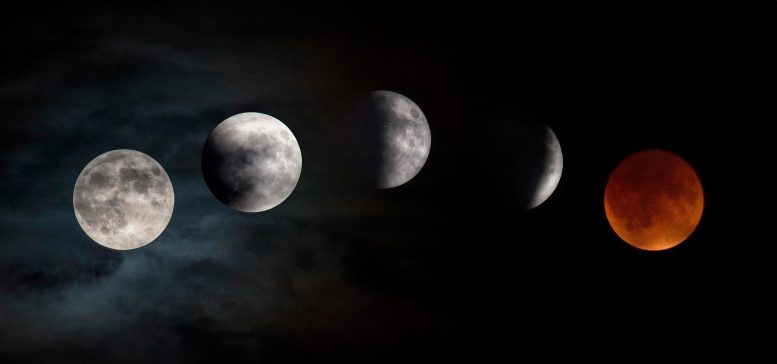March’s Lunar Eclipse Before April’s Solar Spectacle
Lunar eclipses happen during the full moon phase when Earth aligns exactly between the Moon and Sun, casting Earth’s shadow on the Moon. This shadowing dims the Moon and can turn it a vivid red for several hours. Visible from one hemisphere of Earth at a time, there are three kinds of lunar eclipses: total, partial, and penumbral. Credit: NASA
April’s solar eclipse has stolen the headlines for many months now, and rightfully so with millions of Americans in the path of totality.
But did you know there is also a lunar eclipse before the solar eclipse?
As the full moon rises during the late evening of March 24 into the early morning hours of March 25, it will travel through the Earth’s penumbra, or the faint outer part of its shadow. This is called a penumbral eclipse.
Lunar eclipses are categorized into three types: total, where the Moon completely enters Earth’s umbra (the inner shadow), turning it a deep red; partial, where only part of the Moon passes through the umbra; and penumbral, where the Moon moves through only the penumbra (the outer shadow), resulting in a subtle dimming.
When the moon passes through the Earth’s shadow, it causes the Moon to look very unusual for a short period of time. This event is called a lunar eclipse, and it occurs roughly twice a year. Learn more about how lunar eclipses work in this video! Credit: NASA Video
The penumbral lunar eclipse will be visible to all of North and South America. The Moon will dim very slightly over those few nighttime hours, which can make for an interesting timelapse, even if it can be difficult to notice by just a glance at the sky.
Happy skywatching!

Lunar eclipses happen during the full moon phase when Earth aligns exactly between the Moon and Sun, casting Earth’s shadow on the Moon. This shadowing dims the Moon and can turn it a vivid red for several hours. Visible from one hemisphere of Earth at a time, there are three kinds of lunar eclipses: total, partial, and penumbral. Credit: NASA
April’s solar eclipse has stolen the headlines for many months now, and rightfully so with millions of Americans in the path of totality.
But did you know there is also a lunar eclipse before the solar eclipse?
As the full moon rises during the late evening of March 24 into the early morning hours of March 25, it will travel through the Earth’s penumbra, or the faint outer part of its shadow. This is called a penumbral eclipse.
Lunar eclipses are categorized into three types: total, where the Moon completely enters Earth’s umbra (the inner shadow), turning it a deep red; partial, where only part of the Moon passes through the umbra; and penumbral, where the Moon moves through only the penumbra (the outer shadow), resulting in a subtle dimming.
When the moon passes through the Earth’s shadow, it causes the Moon to look very unusual for a short period of time. This event is called a lunar eclipse, and it occurs roughly twice a year. Learn more about how lunar eclipses work in this video! Credit: NASA Video
The penumbral lunar eclipse will be visible to all of North and South America. The Moon will dim very slightly over those few nighttime hours, which can make for an interesting timelapse, even if it can be difficult to notice by just a glance at the sky.
Happy skywatching!
